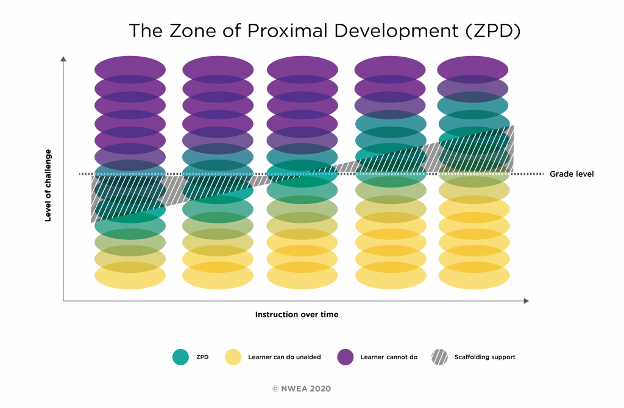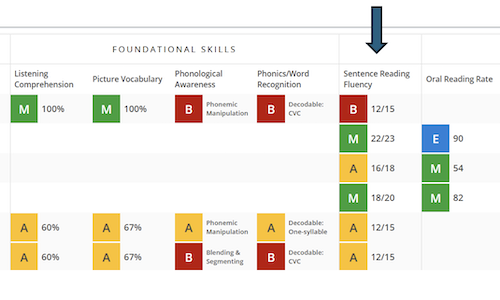The latest research into how kids are doing following COVID-19 school closures shows that achievement is still lagging when compared to pre-pandemic data. Having so many students in need of extra support can be challenging when planning instruction. Identifying where kids are starting, by approximating their zone of proximal development, can help.
Ready, set, challenge!
Knowing where students are in their learning trajectory is the first step in discovering how to challenge and support them so they can grow and reach grade-level standards—that bar that’s set for all your learners. What do I mean by “challenge”? I’m glad you asked. Challenging students means giving them just-right-for-me learning opportunities.
Think of the story of Goldilocks and the three bears. There were porridges of different temperatures, chairs of multiple sizes, and beds of varying degrees of softness. The three bears harnessed the power of knowing what was just right for them to meet their needs for nourishment, comfort, and sleep. Through experimentation in the bears’ home, Goldilocks, too, learned how to become well-fed and well-rested. Whether they wanted to or not (Goldilocks did break in, after all), Mama Bear, Papa Bear, and Baby Bear taught her how to try different things and find her own just-right experience.
While I don’t recommend home invasion as a learning strategy, I do enthusiastically suggest experimentation with a variety of methods and resources. Working from a zone of proximal development in particular can facilitate scaffolding and differentiating instruction in ways that provide just-right and just-in-time supports to increase student access to rich, complex grade-level content. This approach makes the challenging job of supporting all kids toward proficiency in grade-level standards a little easier. It also promotes instructional equity because teacher practice grounded in building a bridge between where a student is (ZPD) and where a student needs to go (mastery of grade-level standards) is all about promoting—rather than denying—access to grade-level content and learning opportunities. This kind of work demands that we both hold high expectations for all students and respond in ways that maximize growth toward mastery.
“Zone of proximal development” defined
By letting you know where they are in their learning, a student’s zone of proximal development can help you move away from an instructional one-size-fits-all approach and toward a time-effective, tailor-made one, with the goal of keeping high expectations and seeing maximized growth for every student relative to grade-level outcomes. You may remember zone of proximal development from your pedagogy or psychology studies. It is a learning theory of Lev Vygotsky, a Russian psychologist and one of the founding fathers of research in education. He defined it as “the distance between the actual developmental level (of the learner) as determined by independent problem solving and the level of potential development as determined through problem solving under adult guidance or in collaboration with more capable peers.”
Zone of proximal development represents the metaphorical gap between what a learner can do and what they can’t do…yet. With the support of what Vygotsky refers to as a more knowledgeable other—a teacher, coach, parent, sibling, peer—learners can engage in increasingly more challenging activities and complex development than they could achieve on their own, without assistance or guidance. This focus on partnership in learning helps students grow academically, and also socially and emotionally, because it fosters building a community of learning.

How do we approximate zone of proximal development?
Because students are always learning and growing, their zone of proximal development changes over time, so it’s important to approximate it often. There are two primary ways to do this: interim assessment and formative assessment. The first supports the second, and chances are you’re doing both of these in your classroom already.
1. Interim assessment
When I served as an executive director of curriculum and instruction in a school district in North Carolina, I was looking for an innovative and efficient way to provide teachers insights to help them plan formative assessment and instruction in a way that was more supportive of individual student learning needs. MAP® Growth™ fit the bill.
Using students’ instructional goal area RIT scores and the MAP Growth Learning Continuum, you can see if a grade-level standard of instruction is likely in a student’s zone of proximal development. That, in turn, can make your formative assessment plan more efficient, which will get you even closer to understanding exactly where your students are in their learning.
2. Formative assessment
I bet you’re constantly collecting data on student learning and their response to instruction through formative assessment. One specific way to use it to determine zone of proximal development is to set percentage thresholds as triggers that prompt your action, in this case, explicitly evaluating if the challenge is just right, the content is appropriate, and additional supports are needed or should be removed.
While I never used formative assessment for grading (and neither should you!) when I taught high school English, I did use the following formative assessment triggers during instruction to evaluate my students’ challenges and needs:
- < 35% correct = content is above the zone of proximal development
- 36–69% correct = content is in the zone of proximal development
- > 70% correct = content is below the zone of proximal development
When students scored with less than 35% accuracy, I used that as a trigger to evaluate whether my instruction was too challenging or targeted on inappropriate content, and I asked myself whether my scaffolds were supportive enough. When students scored with 36–69% accuracy, I continued with my instructional plan. When students scored with greater than 70% accuracy, I explored removing the supportive scaffolds to see if students continued to progress with greater independence and whether I could adjust the level of challenge, adding additional complexity. When I determined the instruction was above or below the zone of proximal development, I made explicit, proactive adjustments to my plans prior to continuing with instruction. When instruction was in the zone, I made real-time adjustments during my instruction.
There is no hard and fast rule for setting assessment triggers. This is just an example of what worked for me. Trust your gut and experience when setting your own, or look to your colleagues for support.
Using zone of proximal development to scaffold instruction
You now know what zone of proximal development is and how to figure it out for each of your students. What’s next? Looking to it to scaffold your instruction. You can read more about that in “7 ways to use ZPD and scaffolding to challenge and support students.”







